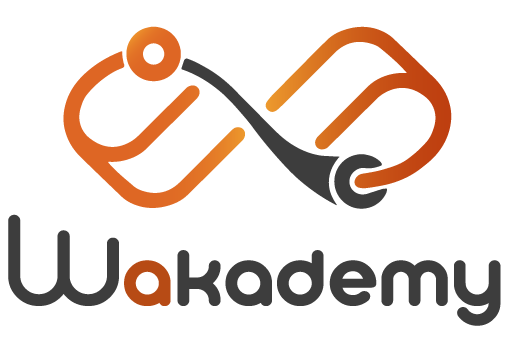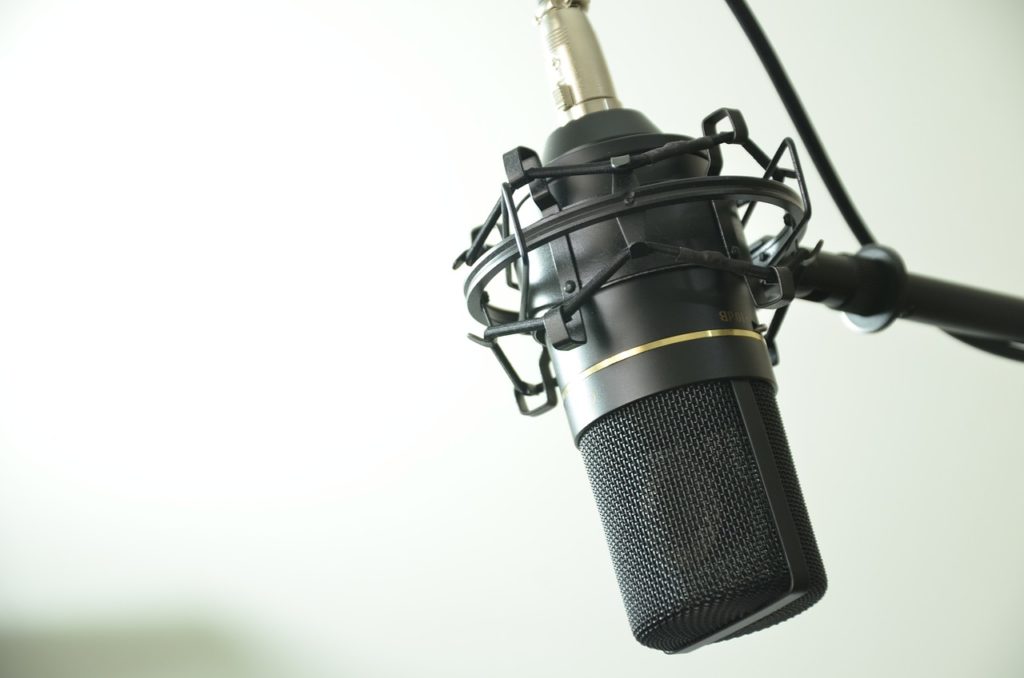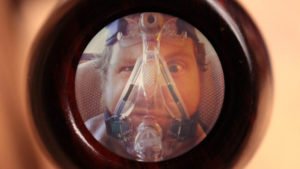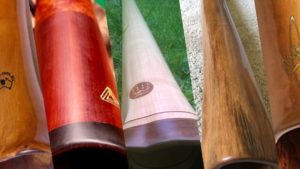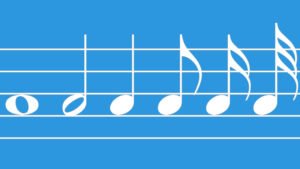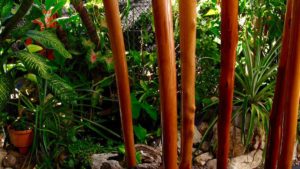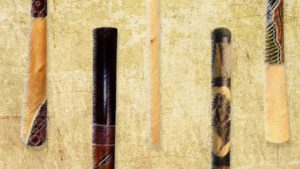If you’ve ever wondered what microphone would be the ideal companion to capture the sound of your didgeridoo, then here’s good news: you’re in the right place! This recurring question, often discussed on the Wakademy forum (and in my inbox 😉), finally deserves a complete answer!
Of course, I could have simply listed the microphones that I use… But you don’t know me well enough, dear didgeridoo friend! I thought the article would be much more comprehensive if I were to also quiz my dear colleagues and friends in the didgeridoo community for their favoritemodels.
Searching for a microphone is about defining (part of) your sound signature (the most important criterion being, of course, the quality of your personal sound and the choice of your didgeridoo). And for that, there’s nothing better than drawing inspiration from different styles, just as a guitarist would try some combinations of their effect pedals and amp in search of a specific sound.
So, a big thank you goes to Zalem, Adèle, Dubravko Lapaine, Stephen Kent, and William Thoren for playing along!
A quick clarification before we dive in: to avoid overloading the article, I decided not to include all the technical details of each microphone. If you’re interested in this information, you can easily find it online. The idea here is to get straight to the point. But before that, I need to go over one essential technical issue, I promise to keep it short!
First of all: 2 main types of microphones
I’m far from being an expert when it comes to the technical aspects of audio recording, but here’s THE basic knowledge to better understand the world of microphones. Let’s keep it simple by keeping in mind there are two main types of microphones:
Condenser Microphones (for studio or home use)
Condenser microphones, also known as capacitor microphones, are characterized by their high sensitivity and extended frequency response.
They are perfect in the studio (or at home) for recording vocals, musical instruments (our beloved didgeridoo), and ambient sounds.
However, their very high sensitivity can be problematic in a noisy environment, making them less suitable for live performance (high risk of feedback, you know, that very high-pitched and extremely unpleasant squeal that can happen during a concert).
Dynamic Microphones (for live performance)
On the other hand, dynamic microphones are known for their ruggedness and ability to handle high sound pressure levels.
Less sensitive than condenser microphones, these microphones are often suitable for noisy environments such as concerts, or on-the-field interviews.
With a dynamic microphone, you may lose a bit of precision and finesse, but you’ll avoid our famous live feedbacks. You’ll also avoid picking up sounds around you (like a drum kit, for example).
In summary, although this rule is far from immutable, remember that:
- If you’re looking for a microphone for a concert (or any kind of live performance): prefer dynamic microphones
- If you’re looking for a microphone to record yourself calmly at home: think about condenser microphones
What microphones to amplify your didgeridoo in concert?
I should mention that all the microphones mentioned in this category could also be suitable for recording at home, no need to spend fortunes at first.
Go step by step, because you’ll realize, the bill adds up (very) quickly!
Shure SM58 – a microphone to avoid!
Dynamic Microphone
Use: often used for vocals (live or studio).
The SM58 is an (extremely) well-known microphone and widely used on many stages.
But let’s say it right away: it doesn’t suit the didgeridoo well (neither for stage nor for studio use). It was Stephen Kent who mentioned the need to avoid this microphone. And I must admit that I agree: I find the sound too bright and aggressive, lacking in roundness.
So maybe for beginners, the Shure SM58 will suit you (maybe you already have one 🫣), but considering the price, I can only recommend the Audix i5, which seems much more adapted to the low/mid frequencies of our didgeridoo.
Audix i5 – Around €100

Dynamic Microphone
Recommended by: Zalem, Adèle Blanchin, and William Thoren
Use: Primarily designed for instrument miking such as electric guitars, snare drums, tom-toms, percussion, guitar amps, but also for vocals.
According to Zalem, Adèle, and William Thoren, the Audix i5 is a good microphone for our didgeridoos, and all for a very reasonable price.
The Audix i5 is very good at handling high levels of acoustic pressure, giving it a certain energy. Adèle and Zalem confirm the dynamics of the Audix I5, which highlights the rhythmic play of the didgeridoo while maintaining a good balance in the roundness of the sound.
As for William, he uses it as a “cheap” version of his on-stage setup when he needs multiple microphones (he uses a rack with several didgeridoos). William also told me that Tyler Spencer (didgeridoo player and North American manufacturer) also uses the Audix i5 on stage.
Zalem amplified by an Audix I5
Zalem and Adèle on stage at the Rêve de l’Aborigène in 2023, sound engineered by Audix i5
AKG C1000S – Around €150

Condenser Microphone
Recommended by: William Thoren
Use: Often used for miking acoustic instruments such as guitars, pianos, percussion, as well as vocals. It is often used as an overhead mic
It’s William Thoren who recommends this microphone. The AKG 1000S was a great find for him because, in his words, it’s like a studio condenser (static) but designed for the stage.
Also, imagine this C1000S as the Live version of the AKG C414 (designed for the studio, I’ll talk about it later). According to Robin Mory, the sound engineer (and friend!) who mixed all my albums, the C1000 is slightly less refined than the C414. But remember, this is the trade-off for a Live microphone. William mentioned that if he could afford five C1000S for his didgeridoo set, he would replace these Audix i5. The C1000S is, along with the EV RE 20, his favorite stage microphone.
Unfortunately, I don’t have any videos that show this microphone in use to share with you. However, here’s a video of William so you can appreciate his style and decide whether you want to get closer to William’s sound. Keep in mind, however, that above all, it’s your didgeridoo (and more specifically its air column) that will determine your sound (also read: 4 essential criteria to understand the psychology of your didgeridoo!).
AKG C535 (replaced by the C636) – Around €450

Condenser microphone
Recommended by: myself 🤗 (and if I’m not mistaken, by Adrien from UCDDidgs)
Use: often used for voice capture, but is known to be very versatile, so it also works very well for other instruments.
In 2015, I played at Rêve de l’Aborigène, and Manu (Manu, if you’re reading this 🙋🏻♂️), who was at the console, suggested the AKG 535 to me. I really liked the sound and balance that came from it. The most striking thing was the faithful reproduction of my acoustic sound. I later learned that the AKG 535 was a very reputable all-around microphone among sound engineers, usable both in concerts and in studios (although there are much better options for recording a didgeridoo, as I’ll discuss below).
Unfortunately, the AKG 535 is no longer manufactured (take a look on eBay). However, it has been replaced by the C636, which is very similar and which I used with Kaophonic Tribu and currently with my my Volte project.
Even though I now only use the C535 for concerts, I used it for recording my album “Renaissance.”
EV RE 20 – Around €600

Dynamic microphone
Recommended by: Dubravko Lapaine and William Thoren
Use: often used for voice capture, but very versatile, it works very well for other instruments too.
The Electro-Voice RE20 microphone is an iconic microphone. Robust and reliable, it is widely used in radio, television, on stage, or in the studio…
It’s a microphone recommended by Dubravko Lapaine, whether for studio or live performances. According to him, for live use, it’s hard to find better.
William Thoren agrees on its studio use but he mentions that he uses it with a Cloud Lifter preamp box. For your information, the Cloudlifter improves the quality of the signal from passive microphones by generating a stronger and cleaner signal, even over long-distance XLR cables.
Dubravko also notes that in the studio, there are much more spectacular microphones, but much more expensive (we’re talking about several thousand euros)…
Dubravko Lapaine amplified by the EV RE 20.
Which microphones to record (or amplify) your didgeridoo in the studio or at home?
AKG C214 – €400

Condenser Microphone
Recommended by: William Thoren
Use: often used for voice recording, acoustic instruments, and amplified instruments such as electric guitars.
William also had the opportunity to test the AKG214, which is cheaper than its big brother, the 414. From his experience, it turns out to be an excellent microphone if you like a relatively bright sound.
SM7B – Around €400

Dynamic Microphone
Recommended by: Zalem
Use: often used for vocal recording in the studio, radio broadcasts, podcasts, or for recording instruments such as guitar and drums.
Zalem, on the other hand, uses an SM7B for studio recording, as well as for his solo didgeridoo concerts (so, with few interferences), where the SM7B replaces the Audix I5.
For studio work, Zalem recommends pairing the SM7B with the AKG C414. This results in, and I quote, “a dynamic/static duo that works wonders! Worth trying!
Zalem and his SM7B
Audio Technica 4050 – Around €700

Condenser Microphone
Recommended by: Stephen Kent
Use: often used for studio recording of vocals, acoustic instruments, electric guitars, drums, and percussion.
Stephen Kent has used many microphones during his long career as a player; he couldn’t mention them all, but he recommends (among others) the Audio Technica 4050 for recording.
Just like with William, I don’t have a specific video of Stephen Kent using this microphone, but here’s one anyway to appreciate his style!
Sennheiser 441 – Around €1000

Dynamic Microphone
Recommended by: Stephen Kent
Use: often used for recording vocals, acoustic instruments, electric guitars, drums, and brass instruments.
Stephen Kent didn’t elaborate much on this, but the 441 is one of the microphones he recommends. A search on the internet shows that the microphone seems very versatile and suitable for both studio and live environments. Have you tried it? Share your experience in the comments!
AKG C414XLII – Around €1000

Condenser Microphone
Recommended by: Dubravko Lapaine, William Thoren, Zalem, Stephen Kent, and myself
Use: often used for studio recording of vocals, acoustic instruments, guitars, pianos, strings, and brass. It is renowned for its versatility.
When I returned to Burgundy in 2020, I contacted Dubravko to ask for advice on a studio microphone (I remembered that in the 2010s, Dubravko had done extensive research on the subject). He recommended, among others, the AKG C414. I then realized that my sound engineer used the same microphone to record the piece “L’exil.” And finally, as I write this article, I realize that it is by far the most popular microphone among all of us.
It’s a very versatile microphone that I use every time I record my didgeridoo (or anything else). My latest album “L’envol” was recorded solely with this one microphone at home (for didgeridoo, violin, and oud).
William Thoren is also passionate about this microphone, but he specifies that he owns the AKG 414XLS, a flatter (less bright) microphone than the XLII. From his experience and for his style, he finds the XLS better for recording his didgeridoo solos.
As for Zalem, as I’ve already mentioned above, he pairs it with his SM7B to get the best of both worlds (in fact, I would be curious to try the combination!).
Finally, Stephen Kent did not explicitly specify this model, but he recommended large-diaphragm AKGs, which means talking about the AKG 414 (it’s definitely a classic) but also the 214 (mentioned earlier by William).
The piece “L’envol” from my latest album of the same name, recorded at home with the AKG C414XLII and mixed at Studio Triphon (by the way, head over to Robin’s, he’s great!).
Neumann U87 – about €2700!

For the most adventurous among you (or the most passionate!), here is one of the legendary models recommended by Stephen Kent, beware, we are in the very high end! It’s the legendary Neumann U87.
After saving up for a while, you might be lucky enough to find it second-hand (this version is highly reputed). Otherwise, you can always opt for a new and contemporary version for around €2700.
However, and I’m just saying, perhaps it’s better to invest in an excellent didgeridoo or even in good training to better master your didgeridoo (promise, Wakademy is cheaper than a U87! 😜).
Choosing a microphone for your didgeridoo, okay… But… how do you connect it?
So, you’ve now decided to treat yourself to a good microphone!? But there’s still a big question: how do you connect it?! And that’s where it gets complicated. 😵💫
In fact, it all depends on your usage: Live or Studio, or playing amplified at home. Depending on these 3 situations, you will need additional equipment:
- Studio Recording: an audio interface to connect to your computer (I haven’t written about this topic yet, for now, I’ll let you search on the internet… be forewarned, it’s vast!). You’ll also need speakers (or headphones). In short, here you start investing in equipment. It’s a real choice that needs consideration but will open the (vast!) doors of the HomeStudio.
- Amplifying at Home: in this case, you have the choice between:
- an audio interface or a small mixer, connected to speakers (or headphones)
- an all-in-one small PA system (amplification + speaker)
- Live Performance: here is the simplest scenario, and if you’re in this situation, you probably already know the answer. You just need to arrive with your microphone and plug it into the equipment waiting for you for the upcoming concert!
An economical alternative to start with: the Zoom
If all these options have put you off like a cold shower in the middle of winter, don’t be afraid, here’s an alternative. There is a simple and much less expensive method than buying a complete and bulky package: an all-in-one digital recorder.
And in this category, one brand stands out above the others: Zoom. With a very good quality/price ratio, they are worth considering.
If you go for a Zoom, maybe avoid the Zoom H1 and opt instead for the Zoom H2 (€150), then the Zoom H4 as a good mid-range option (€200), and if you want the top of the line, treat yourself to the Zoom H6 (€230) known for having good preamps for this price.
Whatever the model, you can plug headphones into it to better hear yourself (also read Adrien’s article on the subject: How my zoom h4n helps me progress with the didgeridoo), but also record yourself.
And finally, another advantage is that you can use their built-in microphones and/or plug in one of the microphones mentioned above!
However, and I’ll stop here, I advise against microphones that connect directly to your computer via USB, such as the Blue Yeti for example. The latter is a microphone designed for podcast recording. So it will quickly saturate with a didgeridoo blowing on it full blast (I tried it in my nomadic years, I quickly stopped!).
Microphones and Didgeridoo Discussion on the Forum (in french)
In his article, I have mentioned the microphones that we recommend as professionals. However, this topic has also been discussed on the Wakademy forum. So you can get an idea of other models recommended by other enthusiasts.
For reasons of brevity, I refer you directly to the links that address the topic on the forum (you need to log in to access the forum):
- What microphone for recording a didgeridoo?
- What microphone for live performance?
- Do you know any microphone references suitable for the didgeridoo?
- What do you use to record your didgeridoo?
- Can you pair a microphone with a smartphone to record a didgeridoo?
In Conclusion
In this article, I have presented you with different microphones that we all use as professionals, and you’re unlikely to go wrong by following these recommendations.
However, and this is far from negligible, talking about a microphone alone is not enough. Remember that a microphone is one of the many links in your audio chain. So if you imagine recording with a Neumann U87 (the most expensive microphone in this article 😉) connected to a Zoom h4, you now understand that such a setup makes little sense.
So if you want to invest in equipment, try to distribute your budget wisely to have a coherent chain. And most importantly, think about your audio interface; the quality of its preamps can vary as much as the microphones.
I am going to write a similar style article on preamps.
In any case, I can only advise you to start slowly, test, and refine your choices little by little. I myself have tested many other microphones before settling on those I mentioned here (and this will certainly change over time). And above all, remember: a microphone, even a very expensive one, will only amplify your sound! So grab your didgeridoos!
And before you go blowing, share the models of your microphones too, it will complement the article!

